Introduction
The nonwoven fabric market is witnessing remarkable growth, fueled by diverse factors and versatile applications across numerous industries. Unlike traditional woven fabrics, nonwoven fabrics are engineered by bonding fibers using chemical, mechanical, heat, or solvent processes. This distinct manufacturing approach imparts a range of advantageous properties, making nonwoven fabrics an appealing choice in various sectors. This article will explore the critical elements driving the burgeoning demand for nonwoven fabrics.
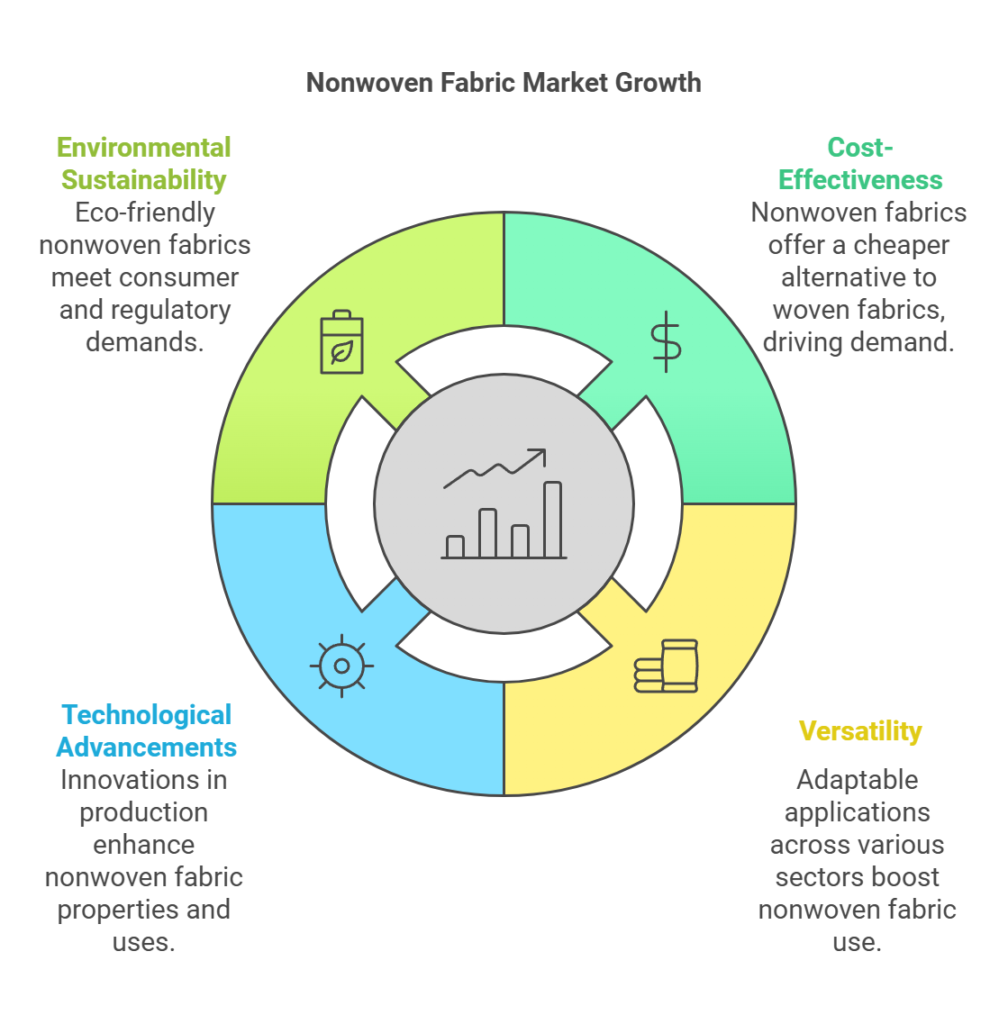
Nonwoven fabrics present several benefits over their woven counterparts, such as cost-effectiveness, versatility, and ease of customization. These fabrics offer enhanced filtration efficiency, breathability, and durability, making them ideal for a wide array of industrial and consumer applications. From healthcare and hygiene products to automotive and construction materials, the adaptability of nonwoven fabrics is contributing significantly to market expansion.
The increasing awareness of environmental sustainability is also propelling the nonwoven fabric market. Manufacturers are continuously innovating to produce eco-friendly, biodegradable, and recyclable nonwoven materials, catering to the growing consumer demand for sustainable products. This shift towards greener options aligns with global environmental goals and regulatory standards, further encouraging market growth.
Technological advancements play a pivotal role in the development and application of nonwoven fabrics. Innovative production techniques, enhanced material properties, and the integration of smart functionalities are pushing the boundaries of what nonwoven fabrics can achieve. As a result, industries are adopting these advanced materials to enhance their products’ performance and meet specific requirements.
As we proceed through the coming sections, we will delve deeper into the myriad factors and trends influencing the nonwoven fabric market’s expansion. Understanding these driving forces will shed light on the dynamic nature of this growing industry and the potential opportunities it holds for the future.
Factors Fueling Market Growth
The nonwoven fabric market has been experiencing substantial growth, propelled by a myriad of factors. A prominent driver is the escalating demand for hygiene products. With an increasing global population and heightened awareness of personal and environmental hygiene, products such as diapers, sanitary napkins, and wipes have seen a significant uptick in consumption. Nonwoven fabrics, characterized by their cost-effectiveness and performance efficiency, are the materials of choice for these products.
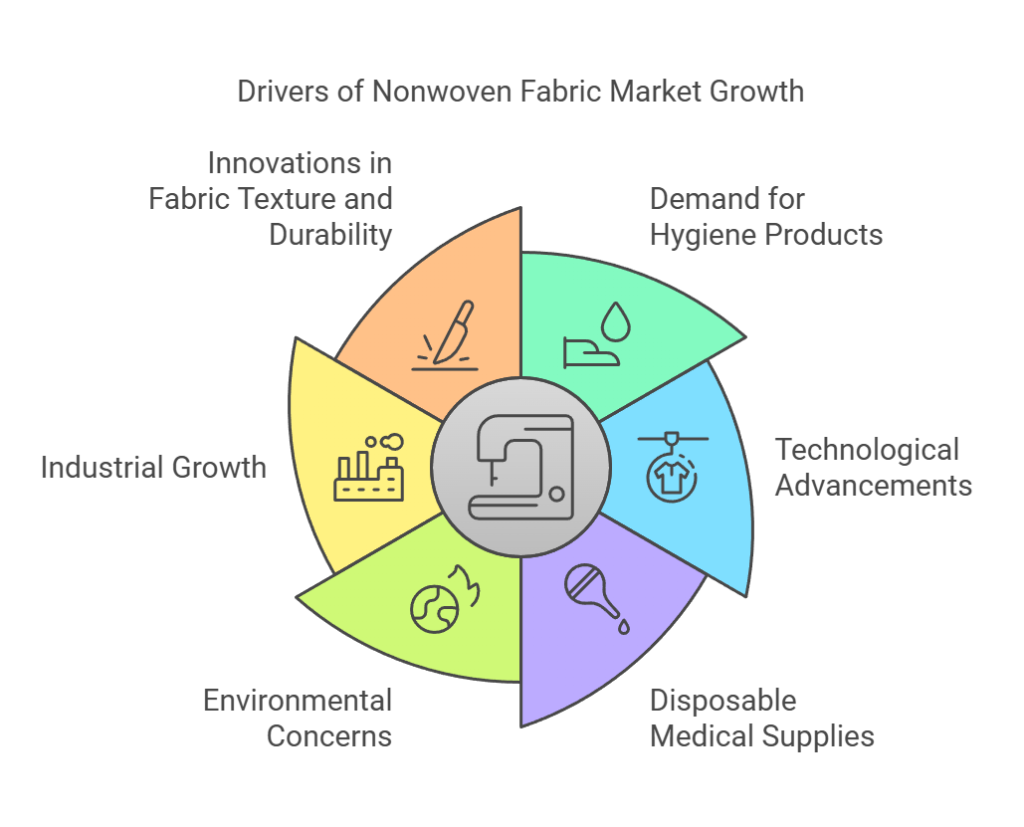
An equally influential factor is the advancement in nonwoven fabric technology. Innovations in this sector have led to the development of fabrics that are not only more functional but also more versatile. Enhanced filtration efficiency, improved elasticity, and better strength are some of the attributes that have broadened the applicability of nonwoven fabrics across various industries, including automotive, construction, and agriculture.
The rise in disposable medical supplies is another critical element promoting market expansion. Nonwoven fabrics are heavily utilized in the medical field for items such as disposable gowns, drapes, face masks, and surgical coveralls. The recent global health crises, such as the COVID-19 pandemic, have underscored the necessity for disposable and hygienic medical products, thereby amplifying the demand for nonwoven materials.
Environmental concerns have also led to a growing preference for eco-friendly products. Nonwoven fabrics, often manufactured from natural fibers or recyclable materials, cater to this demand. Consumers and manufacturers alike are increasingly inclined towards biodegradable and sustainable options, driving the growth of eco-friendly nonwoven fabric alternatives.
Moreover, industrial growth and the subsequent demand for high-performance materials have played a significant role. Nonwoven fabrics, known for their durability and lightweight properties, are integral in various industrial applications ranging from filtration systems to geotextiles.
Lastly, innovations in fabric texture and durability have enabled nonwoven fabrics to closely mimic traditional textiles while providing additional benefits. These innovations not only enhance the aesthetic appeal but also extend the practical utility of nonwoven products, further boosting market adoption.
Applications in Hygiene and Medical Sectors
The versatile nature of nonwoven fabrics has made them indispensable in various hygiene and medical applications. In the hygiene sector, these fabrics are integral to the production of essential items such as baby diapers, adult incontinence products, and feminine hygiene products. The unique properties of nonwoven materials, such as breathability, softness, and high absorbency, make them ideal for these applications where user comfort and product effectiveness are paramount.

Baby diapers, for example, rely heavily on nonwoven fabrics due to their ability to provide good absorbency while remaining soft against a baby’s delicate skin. Similarly, adult incontinence products benefit from the same characteristics, ensuring comfort and confidence for users. Feminine hygiene products also depend on nonwoven fabrics for their softness, breathability, and absorbency, providing women with the reliability and comfort they need.
The medical sector has seen a dramatic increase in the use of nonwoven fabrics, particularly in the wake of the COVID-19 pandemic. The demand for surgical masks, gowns, drapes, and wipes has surged, underscoring the importance of nonwoven materials in providing protective measures against infections. Surgical masks, for instance, use nonwoven fabrics for their ability to filter out pathogens while allowing for breathability. Similarly, nonwoven gowns and drapes are crucial in maintaining sterile environments in medical settings, protecting both patients and healthcare workers. Wipes made from nonwoven materials are essential for their durability, absorbency, and ability to disinfect surfaces effectively.
Overall, the extensive applications of nonwoven fabrics in both hygiene and medical sectors are significant contributors to the market’s growth. The inherent qualities of these materials, such as their absorbency, breathability, and softness, make them well-suited for products that require both comfort and reliability. As public awareness of hygiene and preventive healthcare continues to rise, the demand for nonwoven fabrics in these sectors is expected to maintain its upward trajectory.
Technological Advancements and Innovations
Technological advancements in the nonwoven fabric market have dramatically accelerated its growth. One of the pivotal factors is the continuous improvement in production techniques, facilitating efficient and cost-effective manufacturing processes. The development and refinement of spunbond, meltblown, and composite nonwoven technologies have significantly impacted the market dynamics.
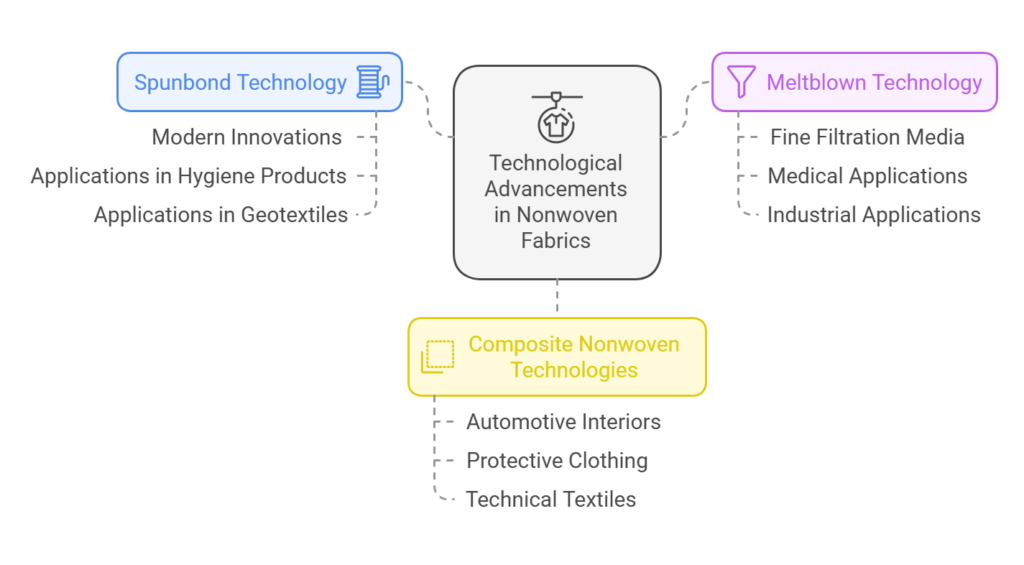
Spunbond technology, a popular method for producing nonwoven fabrics, has seen several innovations. Modern spunbond processes focus on enhancing fiber uniformity and consistency, resulting in fabrics that offer better performance and reliability. These advancements have made spunbond nonwovens indispensable in various applications, from hygiene products to geotextiles.
Meltblown technology, crucial for producing fine filtration media, has also evolved. Innovations in this area aim to improve fiber fineness and distribution, thereby enhancing filtration efficiency. The demand for high-performance filtration materials in medical and industrial applications has driven investments in meltblown technology, leading to the creation of products with superior barrier properties.
Composite nonwoven technologies, combining multiple nonwoven layers or integrating nonwoven fabric with other materials, have led to products with enhanced features. These composites offer a blend of the best attributes of each component, such as the strength of spunbond and the filtration efficiency of meltblown layers. As a result, they find extensive use in advanced applications like automotive interiors, protective clothing, and technical textiles.
Innovation in nonwoven fabric properties has been another driving force. Manufacturers are continually developing new formulations to improve softness, strength, and flexibility. These enhanced features have expanded the usability of nonwoven fabrics in diverse sectors, ranging from personal hygiene to construction.
Overall, the intersection of technological advancements and ongoing innovation has not only bolstered the quality and versatility of nonwoven fabrics but also broadened their application scope, ensuring sustained market growth.
Environmental Impact and Sustainability
The contemporary market for nonwoven fabrics is increasingly influenced by environmental considerations. As awareness around environmental conservation escalates, there is an amplified demand for sustainable and eco-friendly nonwoven materials. Manufacturers are responding proactively by innovating and developing products that are not only functional but also minimize ecological footprint.
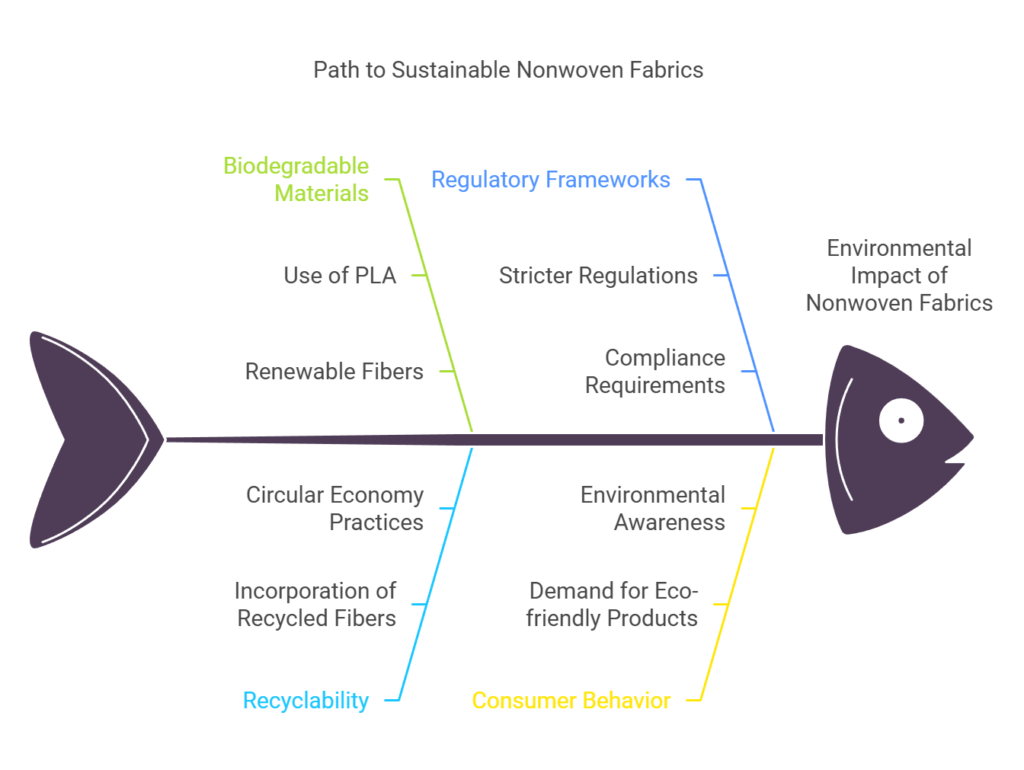
A significant focus is on biodegradable nonwoven fabrics, which can decompose naturally without harming the environment. Materials such as polylactic acid (PLA) and other renewable fibers are being employed extensively. These biodegradable fabrics offer a promising alternative to traditional nonwoven materials made from synthetics, which can contribute significantly to pollution.
Recyclability is another crucial development area. Manufacturers are increasingly incorporating recycled fibers into their production processes. This adoption of circular economies, where materials are reused and recycled, is pivotal in reducing the overall environmental impact. By integrating post-consumer and post-industrial recycled materials, the industry is making strides towards a more sustainable future.
The surge in regulatory frameworks mandating environmental sustainability cannot be overlooked. Governments worldwide are implementing stringent regulations aimed at reducing waste and promoting the use of eco-friendly materials. These regulations are compelling manufacturers to innovate continuously, ensuring that their nonwoven fabrics comply with environmental standards.
Consumer behavior is also a driving force behind the shift towards green products. With increasing awareness and concern for the environment, consumers are more inclined to purchase products that are labeled as eco-friendly or sustainable. This consumer preference is prompting brands to adopt and develop sustainable nonwoven fabrics, thereby reinforcing their market position and aligning with global environmental goals.
In conclusion, the nonwoven fabric market is undergoing a transformative phase driven by environmental impact considerations and sustainability. The concerted efforts of manufacturers, regulatory bodies, and consumers are crucial in steering the industry towards an eco-friendly future, ensuring that nonwoven fabrics contribute positively to environmental conservation.
Regional Market Analysis
The nonwoven fabric market showcases diverse growth rates and distinct characteristics across various regions globally. Key geographic markets, such as North America, Europe, Asia-Pacific, Latin America, and the Middle East & Africa, each present unique aspects that contribute to the overall expansion of this industry.
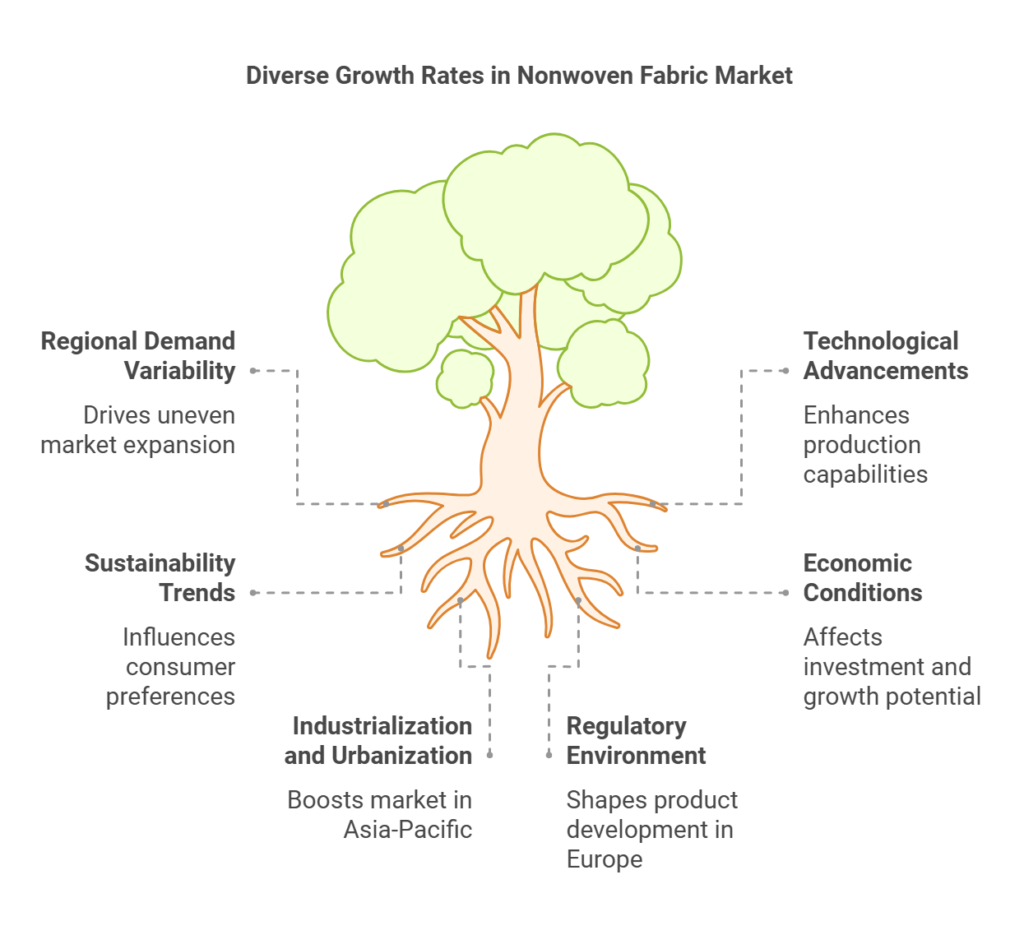
In North America, the nonwoven fabric market is experiencing a steady growth trajectory, driven primarily by advancements in technology and increasing demand from the healthcare and automotive sectors. The United States and Canada are significant contributors, with robust production capabilities and heightened consumption patterns of nonwoven materials in various applications, including hygiene products and filtration systems.
Europe’s nonwoven fabric market is characterized by innovation and sustainability. Countries like Germany, France, and Italy are key players, leveraging their established industrial bases to produce high-quality nonwoven fabrics. The demand for eco-friendly and biodegradable nonwoven solutions is particularly strong in this region, influenced by stringent environmental regulations and consumer preference for sustainable products.
Asia-Pacific stands out as the fastest-growing market for nonwoven fabrics. The region’s growth is propelled by rapid industrialization, urbanization, and increasing disposable income. China and India are leading this surge, with significant investments in manufacturing facilities and expanding applications in hygiene, construction, and geotextiles. Additionally, the rising awareness of hygiene practices has fueled the demand for nonwoven fabrics in personal care products.
In Latin America, the nonwoven fabric market shows potential for growth, albeit at a slower pace. Brazil and Mexico are the primary markets, with increasing usage of nonwoven materials in agriculture, automotive, and healthcare sectors. The region’s growth is supported by economic reforms and the gradual adoption of advanced technologies in fabrication processes.
The Middle East & Africa display a developing nonwoven fabric market. The region’s growth is influenced by infrastructural developments and increasing investments in healthcare. Countries like the United Arab Emirates and South Africa are noteworthy contributors, focusing on enhancing local production capabilities to meet rising domestic demand.
Overall, the nonwoven fabric market demonstrates varied dynamics across different regions, shaped by local economic conditions, industry trends, and consumer behaviors. These regional analyses provide valuable insights into the driving factors and future prospects of the global nonwoven fabric market.
Key Players and Competitive Landscape
The nonwoven fabric market is characterized by intense competition, with numerous prominent players actively participating to gain market share. Among these, Berry Global, Freudenberg, and Ahlstrom-Munksjö stand out as significant contributors to the industry’s expansion.
Berry Global, a leading manufacturer, excels through its diverse product range and innovative solutions. The company focuses on sustainability, emphasizing eco-friendly nonwoven fabrics. Berry Global’s strategy involves strategic acquisitions and partnerships, allowing them to enhance their market presence and broaden their product offerings.
Freudenberg, another major player, is known for its comprehensive portfolio, catering to various applications such as hygiene, construction, and automotive industries. The company’s commitment to research and development has resulted in advanced nonwoven materials with superior functionality. Freudenberg’s market strategy is centered on customer-centric innovation, ensuring that they meet the evolving demands of their clientele.
Ahlstrom-Munksjö’s expertise lies in high-performance fiber-based materials. Their nonwoven fabrics are integral to a range of sectors, including healthcare and filtration. The company’s recent developments in sustainable and specialty solutions have strengthened their position in the market. They focus on leveraging their global production capabilities and technological advancements to stay competitive.
Additionally, the competitive landscape is shaped by regional and smaller-scale manufacturers striving to innovate and capture niche markets. Collaborative efforts among companies, along with investments in state-of-the-art manufacturing technologies, are driving the overall growth of the nonwoven fabric market. The increasing demand for nonwoven fabrics in medical textiles, geotextiles, and personal care products is fueling this competitive environment.
Future Outlook and Market Trends
The nonwoven fabric market is poised for significant growth, propelled by several emerging trends and potential opportunities. As an adaptable and versatile material, nonwoven fabrics are finding increasing applications across various industries, ranging from healthcare and automotive to construction and personal hygiene.
One of the primary drivers behind the market’s positive outlook is the growing global population. As the population expands, there is a corresponding increase in demand for essential products like hygiene items, healthcare supplies, and construction materials. Nonwoven fabrics, known for their durability, cost-effectiveness, and multifunctionality, are becoming an attractive option for manufacturers aiming to meet this rising demand.
Technological advancements are another critical factor that is likely to influence the nonwoven fabric market. Innovations in manufacturing processes, such as the development of sustainable and biodegradable nonwovens, are expected to open new avenues for market growth. These eco-friendly alternatives not only address consumer preferences for environmentally responsible products but also comply with stringent regulatory standards aimed at reducing environmental impact.
Healthcare awareness continues to rise, particularly in light of global health challenges. Nonwoven fabrics are extensively utilized in the healthcare sector for products like surgical masks, gowns, and drapes. Enhanced focus on infection control measures is set to drive sustained demand for these materials, ensuring their prominent position in the market.
Moreover, the automotive industry is increasingly incorporating nonwoven fabrics in vehicle interiors, demonstrating their utility in applications such as filtration, insulation, and carpeting. As the automotive sector evolves with trends like electric vehicles and smart cars, the demand for high-performance nonwoven materials is expected to follow suit.
Market projections indicate robust growth potential, with analysts forecasting a steady increase in the global nonwoven fabric market size. As key industry players continue to invest in research and development, the introduction of innovative nonwoven products tailored to specific applications will likely become a regular occurrence, further bolstering market expansion.
In summary, the nonwoven fabric market is on a promising trajectory, driven by population growth, technological advancements, heightened healthcare awareness, and diversification into new applications. By staying attuned to these trends, stakeholders can strategically position themselves to capitalize on the multitude of opportunities that lie ahead.
FAQs
Nonwoven fabrics are innovative materials with a growing presence in various industries. Here, we address some common questions to provide clarity on their composition, differences, applications, and the latest advancements in the nonwoven fabric market.
What are nonwoven fabrics made of?
Nonwoven fabrics are composed of fibers that are bonded together through a mechanical, thermal, or chemical process. These fibers can be natural, such as cotton or wool, or synthetic, such as polyester, polypropylene, or nylon. The versatility in raw materials allows nonwoven fabrics to cater to a wide range of applications and requirements.
How are nonwoven fabrics different from woven fabrics?
The primary distinction between nonwoven and woven fabrics lies in their construction. Nonwoven fabrics are made by bonding fibers together without interlacing them, which is the hallmark of woven fabrics. This unique construction method endows nonwoven fabrics with distinct properties, such as increased elasticity, absorbency, and filtration capabilities. Consequently, nonwovens often excel in applications where these qualities are essential.
What industries heavily rely on nonwoven fabrics?
A variety of industries depend on nonwoven fabrics due to their unique attributes. The medical sector uses them in surgical gowns, masks, and wound dressings due to their excellent barrier properties and sterility. The automotive industry employs nonwoven fabrics for insulation, carpeting, and filtration. Similarly, these fabrics are prolific in hygiene products like diapers and sanitary pads, owing to their absorbency and softness. The construction and agriculture sectors also benefit from nonwoven materials in applications ranging from geotextiles to crop protection.
Are nonwoven fabrics biodegradable?
The biodegradability of nonwoven fabrics depends on the raw materials used in their manufacture. Nonwoven fabrics made from natural fibers like cotton or wool are generally biodegradable. However, those made from synthetic fibers like polypropylene or polyester may take much longer to decompose. Recent trends in the market have seen a push towards sustainability, with increased research and development focused on creating eco-friendly, biodegradable nonwoven fabrics.
What are some recent innovations in the nonwoven fabric market?
Recent innovations in the nonwoven fabric market have centered on enhancing performance characteristics and sustainability. Advances in nanotechnology have led to the development of nonwovens with superior filtration capabilities, crucial for industries like healthcare and air purification. Innovations in bio-based and biodegradable materials aim to improve the environmental footprint of nonwoven fabrics. Additionally, smart nonwovens incorporating sensors and interactive elements are emerging, opening new possibilities in medical and consumer goods.

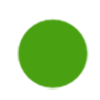
10 Responses
Techarp Very well presented. Every quote was awesome and thanks for sharing the content. Keep sharing and keep motivating others.
Thank you for your kind words! Glad you liked it. Will keep sharing. 😊
Lois Sasson I like the efforts you have put in this, regards for all the great content.
Thank you! Glad you like it.
Isla Moon Hi there to all, for the reason that I am genuinely keen of reading this website’s post to be updated on a regular basis. It carries pleasant stuff.
Nice to hear you like this website. Looking forward to more pleasant posts.
Houzzmagazine There is definately a lot to find out about this subject. I like all the points you made
Thanks! Glad you liked the points. There’s always more to explore on this subject.
Noodlemagazine Nice post. I learn something totally new and challenging on websites
Thank you! Glad our post brought fresh knowledge to you